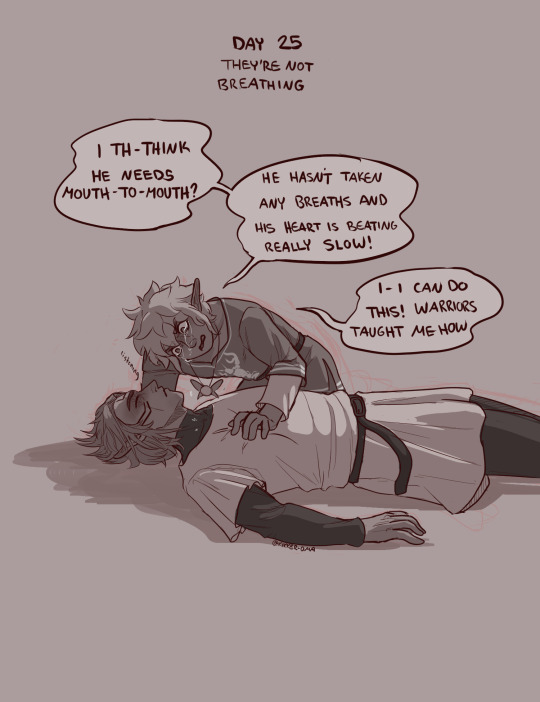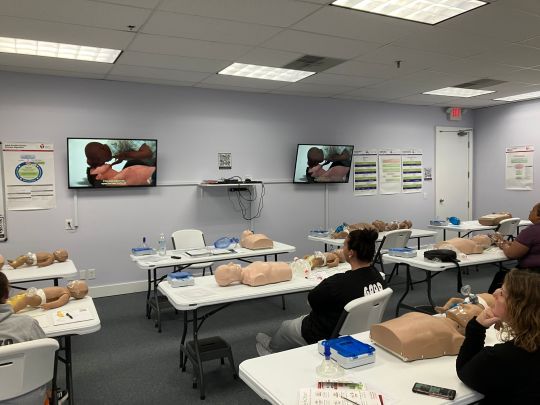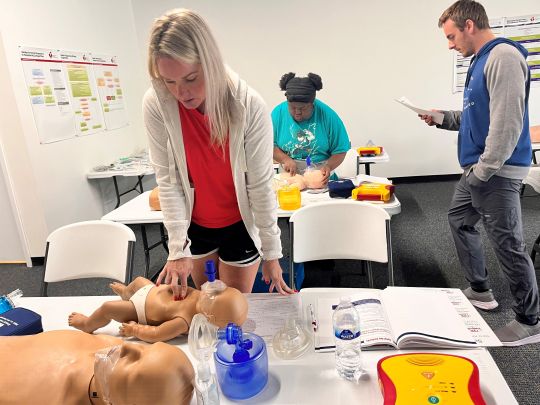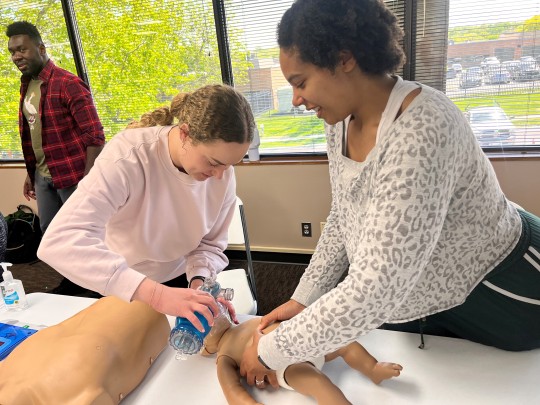#CPR Class
Explore tagged Tumblr posts
Text
Renewing your Basic Life Support (BLS) certification is crucial for healthcare professionals to maintain their skills and knowledge in providing life-saving care. However, many individuals make common mistakes during the renewal process, which can lead to delays or even invalidate their certification.
0 notes
Text
Last week was CPR awareness week but any week is the perfect time to learn CPR. You can literally save a life if you know and use CPR or an AED.
0 notes
Text
Local Cincinnati BLS Renew Classes!
Sign up now to for an American Heart Association Basic Life Support recertification course. This course is the required CPR for healthcare providers. It is designed for nurses, doctors, dentists, EMTs, therapists, paramedics, and all other medical and healthcare related professions. The Day of Class, you will be awarded a 2 year BLS Card certified by the AHA. All components of this course are taught in a relaxed and fun classroom environment by trained AHA instructors.
0 notes
Text
Hands-Only CPR: No Mouth-to-Mouth Needed to Save a Life

In the realm of life-saving techniques, one stands out with remarkable efficiency and simplicity—Hands-Only CPR. Imagine a scenario where someone suddenly collapses, their life hanging in the balance. You, the witness, can be the difference between life and death. This article delves into the brilliance of Hands-Only CPR, elucidating its significance, step-by-step process, and the option to enroll in CPR Indianapolis.
Unveiling the Power of Hands-Only CPR
As a heartbeat dwindles and breaths cease, quick intervention becomes paramount. Hands-only CPR, also known as compression-only CPR, dispenses with conventional mouth-to-mouth resuscitation, focusing solely on chest compressions. This simplified approach increases the likelihood of bystanders initiating CPR, as it eliminates concerns about mouth-to-mouth contact.
The Steps to Heroism
Assess the Situation: Survey the surroundings for safety, tap the person, and shout to ensure responsiveness. Call for Help: Dial emergency services and acquire an AED if available. Begin Compressions: Kneel beside the person, interlock your hands, and position them on the center of the chest. Push hard and fast, aiming for a rate of 100-120 compressions per minute. Continue Until Help Arrives: Keep up the compressions until emergency medical services take over or the person shows signs of recovery.
A Dance Between Science and Compassion
Hands-Only CPR isn't just a sequence of movements; it's a rhythmic dance with science. Chest compressions maintain blood circulation, delivering oxygen to vital organs. This sustained flow buys precious time until medical professionals intervene, drastically improving the chances of survival.
The Compassion That Drives It
While science underpins the technique, compassion fuels its execution. Imagine being the lifeline for someone in their darkest moment. Hands-Only CPR empowers you to take immediate action, bridging the gap between despair and hope.
A Revolutionary Shift: Hands-Only CPR
Simplicity Spurs Action: The absence of mouth-to-mouth removes barriers, making bystanders more likely to intervene. Continuous Circulation: Uninterrupted chest compressions sustain blood flow, preserving brain function and increasing survival odds. Universal Applicability: Hands-Only CPR is suitable for adults, increasing the reach of potential lifesavers.
Enroll in CPR Indianapolis: Be the Hero
In the vast expanse of Indianapolis, a call to action echoes. Enroll in CPR Indianapolis, where you can learn the art of Hands-Only CPR from experienced instructors. Acquire the skills that empower you to be the beacon of hope when time is of the essence. Visit CPR Indianapolis and embark on a journey to become a certified lifesaver.
0 notes
Text
Stay Prepared: CPR Nashville for Lifesaving Training in 2023!
When it comes to life-saving skills, there's nothing more valuable than knowing CPR. In 2023, CPR Nashville is your destination for comprehensive CPR training. Operated by the American Heart Association, CPR Nashville offers top-notch lifesaving courses that equip you with the knowledge and confidence to act swiftly in emergency situations. Discover why CPR Nashville is the go-to choice for staying prepared and saving lives.
Stay Prepared: CPR RENEW Nashville - Lifesaving Training Experts
At CPR Nashville, we take pride in being an American Heart Association training site that focuses on delivering high-quality CPR training. Our experienced instructors are experts in their field, with a deep understanding of the latest techniques and guidelines. When you choose CPR Nashville, you're choosing a team dedicated to equipping you with the skills you need to confidently administer CPR and save lives.
Why Choose CPR Nashville?
Accredited Training: Our courses are officially recognized by the American Heart Association, ensuring that you receive accurate and up-to-date information.
Hands-On Experience: Our training is practical and hands-on, allowing you to practice CPR techniques in a simulated environment.
Expert Instructors: Learn from knowledgeable instructors who bring real-world experience and insights into the classroom.
Flexible Learning: We offer various learning formats, including in-person classes and online options, making it easy to fit training into your schedule.

The Importance of CPR Training
CPR, or Cardio-Pulmonary Resuscitation, is a critical skill that can mean the difference between life and death. In emergency situations like cardiac arrest, every second counts. When you're trained in CPR, you can provide essential chest compressions and rescue breaths that keep oxygen flowing to the brain and other vital organs. This immediate action can significantly increase the chances of survival until professional help arrives.
Exploring CPR RENEW Nashville Courses
CPR Nashville offers a range of courses designed to cater to different needs and skill levels. Whether you're a healthcare professional looking to renew your certification or a concerned citizen eager to learn lifesaving techniques, we have a course for you. Our courses include:

Basic Life Support (BLS): Ideal for healthcare providers, this course covers advanced CPR techniques, the use of AEDs, and more.
Heartsaver CPR/AED: Geared towards the general public, this course teaches CPR basics and how to use an AED effectively.
PALS (Pediatric Advanced Life Support): courses are an option for critical care and pre-hospital rescuers that work frequently with children and infants.
ACLS (Advanced Cardiovascular Life Support): courses are also available for critical care hospital staff and emergency medical personnel such as paramedics.
HeartSaver First Aid covers some of the most common illness and injuries that can affect anyone. It provides the skills necessary to recognize, respond to, and treat these emergencies until advanced medical care can be obtained.
Online (HeartCode) CPR Certification: While online CPR courses are available, it's important to note that in-person skills assessment is typically required for full certification. The AHA and many employers often require hands-on practice to ensure the competence of individuals in performing CPR.

FAQs (Frequently Asked Questions)
How often should I renew my CPR certification?
You should renew your CPR certification every two years to ensure you have the latest information and techniques.
Is CPR certification only for medical professionals?
No, CPR certification is beneficial for everyone. Anyone can learn CPR and potentially save a life in an emergency.
Are online CPR courses as effective as in-person training?
Yes, online CPR courses can be just as effective when they are accredited and include hands-on practice components.
Can I take a CPR course if I have no medical background?
Absolutely! CPR courses are designed to be accessible to individuals with varying levels of medical knowledge.
What is the role of an AED in CPR?
An AED (Automated External Defibrillator) is a device used to deliver an electric shock to restore the heart's normal rhythm during cardiac arrest.
How long does a typical CPR training session take?
The duration of CPR training can vary based on the course. Basic courses can take around 2-3 hours, while more advanced courses might require longer.
Conclusion
In a world where emergencies can happen at any time, being prepared is paramount. CPR Nashville offers the opportunity to gain essential skills that can make a life-saving difference. By choosing CPR Nashville, you're not only investing in your own knowledge but also contributing to a safer community. Join us at CPR Nashville and be equipped to take action when it matters most.
1 note
·
View note
Text
my friends recommended the apothecary diaries to me like a whole year ago and i finally watched it and i love it so much. i love maomao so dearly. i will never say no thank you to another off-putting autistic girl in anime!! she's so ace yet in solidarity with sex workers above all else. what IF sherlock holmes was a stray cat of a teenage girl everyone gives little treats and mysteries to. for enrichment
#she knows class consciousness and cpr. and a million other unrelated facts that WILL become relevant#between falin frieren and maomao last year was a good year for autistic anime girl rep huh#and of course i am not immune to the trope of The Most Beautiful Man In The World has fallen for this absolute gremlin#and is quite pathetic about it. i have fun
54 notes
·
View notes
Text

*dialogue was edited to hopefully fix my lack of cpr knowledge and not make Wind do chest compressions when Time still has a heartbeat hehe*
#ive already resigned myself to the fact that im running 1-2 days behind#ill try to catch up this weekend for the last stretch!#linked universe#linkeduniverse#lu fanart#lu time#lu wind#whumptober2023#whumptober#my cpr ignorance is shining through since its been 14 years since the class lol#please ignore any inconsistencies#😅
786 notes
·
View notes
Text
no because like… if i woke up in pain in a hospital bed one day, and the doctors told me i lost consciousness earlier that day and some stranger saved my life by doing cpr on me but she accidentally managed to break my ribs in the process, and the prettiest girl i’ve ever seen walked into the room with a flower bouquet with a handwritten note with an apology attached to it— i wouldn’t be too mad abt it yk. especially not if said girl paid me a visit every now and then, yk… as an apology for breaking my ribs.
take notes ladies 🙂↕️ this is how you win me over 🗣️
edit: WHY DID THIS FUCKING POST RESONATE WUTH PEOPME WTF
#yes this is what i was thinking abt in class today instead of paying attention to what the teacher was teaching us abt cpr#yes i am uh#a tad bit insane? hahaha#send help.#anygays#i am gay. very gay.#very very gay#what in the wattpad did i accidentally cook up 😞#jamstag#praying my moots don’t see this#which is kinda stupid considering I POSTED THIS#uhh
23 notes
·
View notes
Text

#c programming#cpr#cpr certification#cpr classes#cpr rp#cprattedit#cprdefib#cprtraining#feetpics#feetpose#heartbeat#heartbreak#heartstopper
25 notes
·
View notes
Text
My Hero Academia: CPR + BLS
You know, Pro-Hero is probably one of those professions where it's mandatory to know CPR and Basic Life Support. Because after the villain's been taken out or all the people have been evacuated from a disaster zone, the Pros and their sidekicks are definitely the first responders until the paramedics arrive on scene.
And the idea that Aizawa, Endeavor, Mirko, Best Jeanist, Hawks, Ryukyu, everyone has to re-certify every two years is really, really hilarious to me. It's just so absurdly mundane.
If your job doesn't require CPR certification, let me break this down for you: You sit for two hours give or take, watch a video that's you've probably seen before, maybe take a brief test, and demonstrate that you can in fact perform CPR on a mannequin as well show you can use an AED kit and maybe demonstrate the Heimlich maneuver, and then you wait for an email that has your certification cards. It's tedious and the information doesn't change very much, but it is essential to review, so you suck it up and you be as diligent as you can because there could absolutely come a day where you will be in an emergency situation and need to use these skills. Nonetheless, you really just want to get on with the written and practical tests and get out of there.
That said...Hawks is definitely an annoying prick who keeps asking questions just to purposefully draw out the session.
Kaminari would probably bring snacks, suddenly start choking, and become the unwitting live demonstration.
Iida studied beforehand, took notes throughout, and then got way too into the practical exam. (Because you are often acting out a simulation to prove you are adhering to proper safety measures.)
Mineta...can he even...?
#my hero academia#headcanons#cpr and bls certification#pro heroes#boku no hero academia#bnha#mha#pro hero license protocols#first air#hawks#endeavor#mirko#aizawa#class 1a students
132 notes
·
View notes
Text
CPR Training Instructors play a pivotal role in equipping individuals with life-saving skills, ensuring they’re prepared to respond to emergencies effectively. As a certified instructor, you have the opportunity to empower others and make a meaningful impact on their ability to save lives.
0 notes
Text
jammer had it right!
when you do CPR, you keep it going until EMTs or otherwise higher level medical help arrives.
if someone is unconscious and not breathing, you probably won't bring them back to awareness. the dramatic 'gasping awake' kind of reaction isn't necessarily realistic.
the mechanism of Cardio Pulmonary Resuscitation is to essentially keep the person's blood somewhat oxygenated and circulating in the absence of breath or heartbeat. you are manually stimulating circulation by squeezing their heart for them via chest compressions. even if they appear to have died, you can prevent long term damage, particularly to the brain, by performing CPR in case they can be revived via more invasive means. even if that means taking turns with other people (because it is tiring to do chest compressions), don't just decide that someone is dead and CPR isn't doing anything. keep it going as long as you know that help is on the way.
if you are by yourself or emergency help is not coming, just keep it going as long as you can.
bonus: if you are ever in a situation where someone has lost an extremity and is bleeding out, use a tourniquet. you really only want to use one when you know that the flesh below it can't be saved because the point of a tourniquet is to cut off blood flow and that usually results in tissue death. use non-stretchy fabric or a belt. there are some ready made tourniquets that have a quick release mechanism built in, if you keep a first aid kit. if you are able to write the time you first applied the tourniquet on the bandage itself, that's really helpful information for EMTs/medics to have.
#misfits and magic#lifesaving skills#everyone should have some basic lifesaving skills under their belt like CPR and 'stop the bleed' classes#'dramatic gasping awake' can happen *sometimes* but its not the goal of CPR#when i took narcan training my teachers emphasized that people will snap out of their OD very abruptly and potentially aggressively tho#narcan only lasts for fifteen minutes tho so it is also a thing where it's to buy you time until you can get to a hospital
32 notes
·
View notes
Text






#beyblade x#beyblade#jaxon cross#robin kazami#chrome ryugu#Eugh I hope I don’t flood the tags#these are stupid memes I made after finding quotes#I BLURRED OUT THE NAMES IN CASE#um. yeah maybe you guys won’t find this funny#im sorry I have bad humor forgive me#IM DYING why did I post this nervously before my CPR first aid test for health class#laughs at these unfunny things nervously#I have one of chrome but um#IDK if you guys would wanna see it#he says kys a little much#BUT YEAHHHHHHHHHHHH#sobs#im sorry OH SHIT CLASS#imagine Ekusu breakdancing though that would be funny if
8 notes
·
View notes
Text
Essential CPR Training in Indianapolis: Learn Life-Saving Techniques Today
Have you ever found yourself in a situation where someone suddenly collapsed and stopped breathing? It's a scary thought, but knowing how to perform CPR (Cardiopulmonary Resuscitation) could mean the difference between life and death. In Indianapolis, CPR training is not just a skill; it's an essential tool that everyone should have in their toolbox. Whether you're a concerned parent, a responsible coworker, or simply a caring citizen, learning CPR can empower you to save lives. This article will guide you through the importance of CPR training in Indianapolis and how it equips you with life-saving techniques.
1. What is CPR?
Cardiopulmonary Resuscitation, or CPR, is a life-saving technique used in emergencies when someone's heartbeat or breathing has stopped. It involves a combination of chest compressions and rescue breaths to circulate oxygenated blood throughout the body, keeping vital organs functioning until professional medical help arrives.
2. Why is CPR Training Important?
Imagine being able to take immediate action if a loved one, a coworker, or even a stranger experiences sudden cardiac arrest. CPR training equips you with the skills and confidence to intervene effectively in such critical moments. Rapid administration of CPR can double or even triple the chances of survival, making you a vital link in the chain of survival.

3. The Basics of CPR
Performing CPR may seem daunting, but it's simpler than you think. First, ensure the person is lying on their back on a firm surface. Kneel beside them, place the heel of your hand on their chest just above the center, and interlock your other hand on top. Push hard and fast, aiming for a rate of 100-120 compressions per minute. Remember, you're pumping life back into their body with every compression.
4. Finding the Right CPR Class in Indianapolis
Choosing the right CPR class is crucial to receiving effective training. Look for reputable organizations that offer hands-on practice, up-to-date guidelines, and experienced instructors. Whether you're a healthcare professional or a concerned citizen, there's a CPR class in Indianapolis tailored to your needs.
5. Hands-on Practice: Mastering Chest Compressions
Effective chest compressions are the cornerstone of CPR. During training, you'll learn the proper technique to ensure you're providing sufficient depth and rate of compressions. With practice, you'll develop the muscle memory needed to perform compressions accurately, maintaining blood flow to vital organs.
6. Rescue Breaths: Giving Oxygen When It Matters
Incorporating rescue breaths between compressions helps deliver oxygen to the person's lungs and body. Training will guide you through the correct method of tilting the head, lifting the chin, and giving effective breaths. Remember, every breath you provide could be the breath that saves a life.

7. AEDs: Automated External Defibrillators Demystified
AEDs are user-friendly devices designed to shock the heart back into a normal rhythm during cardiac arrest. CPR training will teach you how to use these devices effectively and integrate them into your life-saving efforts. Knowing how to locate and use an AED can significantly improve the chances of survival.
8. CPR for Infants and Children: Tailoring Your Techniques
CPR techniques for infants and children differ from those for adults. Proper training will teach you how to adapt your approach, ensuring you provide the right amount of pressure and breaths for smaller bodies. Whether you're a parent, caregiver, or teacher, this specialized knowledge is invaluable.
9. Gaining Confidence: Mock Scenarios and Simulations
Hands-on practice with mock scenarios and simulations can boost your confidence in applying CPR. Training sessions often simulate real-life emergencies, allowing you to practice your skills in a controlled environment. This experience prepares you to respond calmly and effectively when faced with an actual crisis.

10. CPR Certification: Your Ticket to Preparedness
Completing CPR training often leads to certification, a testament to your commitment to saving lives. CPR certification not only enhances your skill set but also demonstrates your dedication to the well-being of your community. Many employers and organizations value employees with CPR certification, recognizing their ability to act decisively in emergencies.
FAQs
Q1: Can anyone learn CPR?
Absolutely! CPR training is designed to be accessible to everyone, regardless of age or background. It empowers anyone with the ability to make a difference in a life-threatening situation.
Q2: How long does CPR training take?
The duration of CPR training can vary depending on the course. Some basic courses can be completed in a few hours, while more comprehensive courses may take a day or more.
Q3: Is CPR only for medical professionals?
Not at all! While medical professionals can benefit from advanced CPR training, basic CPR skills are valuable for anyone. Bystander intervention can significantly improve survival rates.
Q4: Can I hurt the person while performing CPR?
When performed correctly, CPR is unlikely to cause harm. It's better to attempt CPR and potentially save a life than to do nothing in a critical situation.
Q5: Do I need to renew my CPR certification?
Yes, CPR guidelines and techniques can evolve over time. Renewing your certification ensures you're up to date with the latest best practices, maximizing your life-saving impact.
In conclusion, CPR training is an essential skill that every individual should acquire. It empowers you to take decisive action in emergencies, potentially saving precious lives. By learning CPR in Indianapolis, you're not just gaining knowledge; you're becoming a crucial link in the chain of survival. So why wait? Enroll in a CPR class today and be prepared to make a life-saving difference.
1 note
·
View note
Text
August: Day 19
Adventures
Tried a mochi donut for the first time. It was okay.
Accomplishments
Completed a CPR/first aid refresher course
#adventures in august#turns out the cpr class isn't the certification i needed#(i just assumed 'oh work is offering it i must be good')#so i'll need to find an actual bls class#but afaik i got paid for this so it's not really a loss#just a couple hours refreshing the very basics
25 notes
·
View notes
Text
I understand that not everyone comes from a family that's 50% search and rescue, paramedics, CERT leader type people and 50% hunting, fishing, camping, rock climbing type people but sometimes it baffles me that people can get into adulthood without even taking one (1) cpr/first aid class. Brother you work in a workplace. What are you going to do if Susan has a seizure while you're here? How are you going to help if Brian chokes on the management-provided pizza? Frankly I'm not sure I trust any of you to handle me if I have a medical issue on the clock.
#chit chat#work stuff#i will trust suzie because she knows more than any of you??? simply due to living with a chronic condition???#there's like 5 people who are required to be cpr certified but they all work up front#there's like maybe 10 others who have taken cpr classes just in general#and im one of them
26 notes
·
View notes